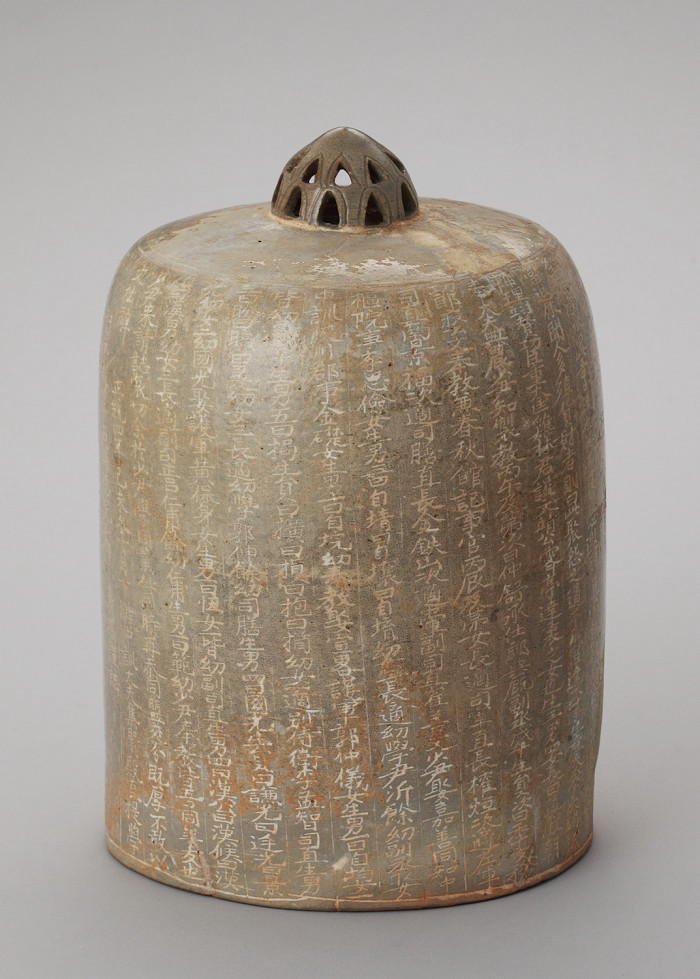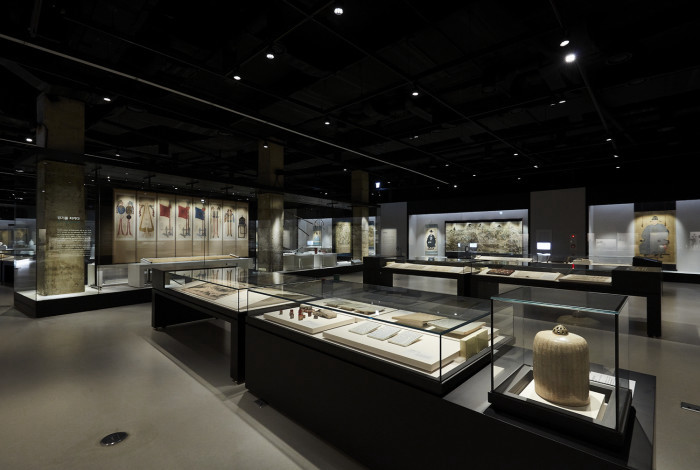GyeongGi Cultural Foundation
Gyeonggi observers excluded from the region
The 2020 Joongbu Ilbo series 〈Gyeonggi-do Museum〉 is a content produced in a total of 10 series by the GyeongGi Provincial Museum, which has undergone a complete reorganization of the exhibition hall in celebration of the 25th anniversary of its opening. If you would like to see more detailed 〈Gyeonggi Province Museum〉, you can enjoy it in the original text on the Jungbu Ilbo website. |
Governing GyeongGi

[Photos] Inlaid with Buncheong-sagi “4 Years of Orthodox” Kim Myeong-ri Cemetery Treasure No. 1830 Joseon 1439 Andong Kim's Moonon Gong Pa commission 11 years (1411).
This is a graveyard that contains the family line and history of Kim Myung-ri (1368-1438), who served as Gyeonggi-do (current Gyeonggi-do vice governor). This is a rare example of a cemetery decorated with lotus buds with an openwork at the top in a bell shape.
“Trees have roots, grow and grow, and water flows from springs to the sea.
The existence of a mechanism in a country is like a tree having roots and a spring in water.
The good and bad politics of the mechanism has to do with the weight of the whole country, and the gentle and sick of the customs has to do with the Oryung in all directions.”
-From a textbook given to Gyeonggi observer Im Baek-ryeong in 1540 (35th King Joongjong)-

[Photo] GyeongGi Provincial Museum Goryeo Shipbuilding Room
The existing space (Room type) that was divided into exhibition rooms by subject was changed into one large space (Hall type), and the openness was maximized by exposing the walls and ceiling. In particular, the columns that can represent the history of the building were exposed and actively used for exhibitions to create a modern space.
Gyeonggi (京畿) was a term referring to the outskirts of the capital city, and it was also referred to as Wangki (王畿) and Gijeon (畿甸). The Joseon Dynasty divided the whole country into 8 provinces in 1413 (Taejong 13) and dispatched local government officials, the agency of the royal authority. Through this, a strong centralized system was established, leading to the king, the observer, and the leader. Observation station (觀察使) was also often referred to as Ga-geun (監司), Dobaek (道伯), and Bangbaek (方伯). About 650 people served in this position, starting with Jang Ja-chung, the first observer, and Kim Sa-muk, the last observer in 1908.
In the "Gyeongguk War", the observer was defined as a species 2 pum, but in reality, there were many cases where a higher priest was appointed. The subject of appointment as an observer had to go through difficult conditions. Those who were caught bribery or had wrong conduct, should not have been from the province. According to the rules of the epithelium, if there were relatives serving in the same province, they could not be divorced. The appointed observer received a textbook and an ax from the king. Observers were given strong authority and played an important role in diplomacy and national defense, and the ruling power was an important position.

[Photo] Gyeonggi-do officials' work evaluation form (京畿道褒貶等第), Data on the military performance of Gyeonggi-do officials in the 24th year of Soonjo (1824).
The observer inspected all heads in the hall and evaluated the work twice a year. This evaluation is one of the absolute powers of the observer as it is directly related to rewards and discipline.
◆ Appointed as a GyeongGi observer
'Gyeonggi' was the largest province among the eight provinces as the jurisdiction around the capital, and the observer who was in charge of this was a heavy duty and was given strong authority accordingly. The authority to report directly to the king [immediate authority], the military command of the heads of the province, and commanding all military and civil affairs in the province.事) could not act on behalf of the observation resignation.
Gyeonggi-do was the largest of the eight provinces, and in many cases, Suwon-bu, Gwangju-bu, Kaesong-bu, and Ganghwa-bu were also co-employed. As such, Gyeonggi-do has always been one of the most important places for the ruling powers as it has been an important area for administration, diplomacy and defense.
In addition, “Gyeonggi” is the place where the king’s teaching [王化] first affects, and a new policy was experimentally implemented. They also had to pay more taxes and subsidiaries than other regions. The royal tombs and tombs of influential families in the center were located. Therefore, the royal tomb's bongshim (奉審) was one of the main duties of the Gyeonggi-do observer, and the management of Neungwon tombs included the provision of goods necessary for the incense. In addition, the maintenance and preparation of the neunghaeng route was also an important task for the Gyeonggi-do observer if there was the king’s ability to perform.

[Photos] Cheongwon-gun Simdae Hoseonggongshin Textbook (靑原君沈岱扈聖功臣敎書), Treasure No. 1175 Joseon 1604 Cheongsong-shim donated to Chungjang Gongpa 25 years (1592)
This is a textbook to rebuke Shim Dae, who died in the battle against Wajeok at Deungpinaru in Sakkyeong-gun (now Yeoncheon) to restore Hanyang as a Gyeonggi observer.
◆ Change in the location of the GyeongGi
Gamyeong (監營) refers to the place where the observers of each province lived and handled the business, and Gyeonggi Gamyeong was also called the nickname Kiyeong (畿營). Gamyeong is made up of leaders such as careers, masters, judges, etc. dispatched to assist observers, and more than 9 officers engaged in practical administration.
In 1413 (Taejong 13), Gyeonggi Gamyeong was established in Suwon, where it was previously located. Soon afterwards, Gamyeong was moved to Gwangju, and it was installed in a Bansong room outside Donuimun of the Hanseongbu during the King Sejo period. During Gwanghae-gun, Yeongpyeong and Pocheon were merged, and Gyeonggi Gamyeong was moved there after being promoted to Yeongpyeong Daedohobu, but after the Injo Banjeong, they returned to Hanseongbu. Gyeonggi Gamyeong, located outside Donuimun, burned down in 1636 (14th year of King Injo) after suffering sickness. At this time, it was moved into the city center for a while and settled in the northwestern part of the Hanseongbu. In 1641 (19th Injo), Gamyeong was rebuilt outside Donuimun, the old site.
In 1895 (Gojong 32), when Gojong reorganized the local administrative district, he changed the Gyeonggi Observatory to Hanseong Observatory, and the following year changed it to the Gyeonggi Observatory and moved to Suwon. In 1910, Gyeonggi-do was incorporated into Gyeongseong-bu, and Gamyeong was moved to Gwanghwamun, and then to Suwon in 1967.
-Sungjoon Lee (Curator, GyeongGi Provincial Museum)-
<Copyright(c)2002 GGC All rights reserved.>
- Writer
- GyeongGi Cultural Foundation
- About
- Everything about the GyeongGi arts and culture, GGCF
- homepage
- https://www.ggcf.kr/